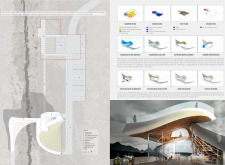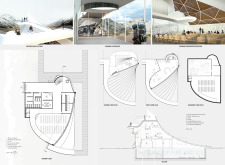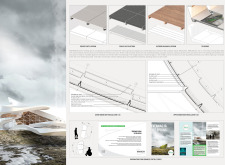5 key facts about this project
"Wanderland" functions as a multifunctional center designed to enhance the visitor experience through an immersive connection with nature. It serves various roles, including an exhibition space, a café, and an educational facility focused on environmental issues. The design encourages exploration and interaction, inviting visitors to not only observe but also learn about the importance of preserving the fragile ecosystems of Iceland. The architectural choices made in this project emphasize functionality while also celebrating the local context.
One of the most important elements is the building's multi-level design, which allows for dynamic spatial organization and varying perspectives on the surrounding landscape. Visitors can traverse the different levels to experience distinct views and interactions with nature. The circulation throughout the space is carefully crafted through a core ramp system that allows for seamless movement, making it accessible to all visitors.
The choice of materials is a significant aspect of "Wanderland," where sustainability and local resources play a vital role. The architects selected materials such as sustainable wood, green roof systems, and recycled components, all of which contribute to the building's environmental objectives. The use of glass and steel creates an open and airy feel, promoting transparency and visual connectivity between the interior and exterior environments. These materials not only enhance the building's aesthetic but also support its eco-friendly stance.
Landscaping around "Wanderland" has also been thoughtfully rendered. Native flora is integrated into the surrounding areas to ensure that the design complements rather than disrupts local ecosystems. This landscaping approach demonstrates a careful consideration of biodiversity and the interplay between architecture and nature.
Unique design approaches are evident throughout "Wanderland," particularly the emphasis on site responsiveness. The shape and form of the structure mimic the surrounding landforms, creating a sense of unity with the environment. This sensitivity to context allows the architecture to blend harmoniously into its setting, fostering a deeper appreciation for the natural beauty that defines Iceland.
The project also integrates educational components, with spaces designed to accommodate lectures, workshops, and exhibitions that focus on sustainability and environmental awareness. By engaging visitors in thoughtful dialogue about ecological conservation, "Wanderland" encourages a perspective of stewardship towards nature.
For a more in-depth exploration of the "Wanderland" project, including its architectural plans, sections, and innovative design ideas, readers are encouraged to engage with the full presentation of this architectural endeavor. Examining these elements will provide a comprehensive understanding of its significance within the realm of architecture and its contributions to thoughtful design in harmony with the environment.


























